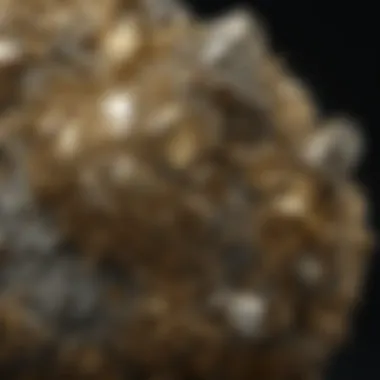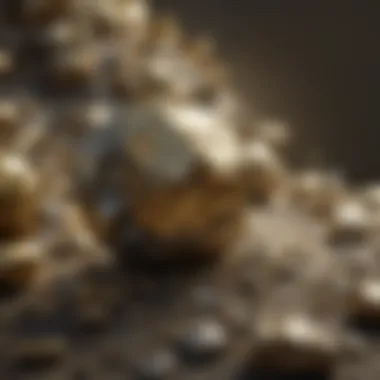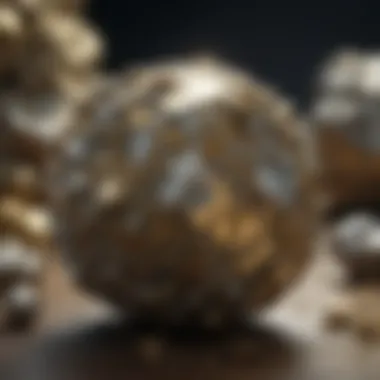Unveiling the Enigmatic World of Pyrite: Properties and Significance


Rock and Fossil Identification
Pyrite, a mesmerizing mineral known for its striking resemblance to gold, captivates both novice collectors and seasoned geologists alike. Understanding the distinct characteristics of pyrite is essential for enthusiasts delving into the world of rocks and minerals. In the realm of rock and fossil identification, pyrite stands out for its metallic luster and brassy hue, often fooling unsuspecting eyes with its golden brilliance. Geologists identify pyrite based on its cubic crystal structure and hardness of 6-6.5 on the Mohs scale, distinguishing it from other minerals. Novice collectors may utilize specialized tools like a hardness kit and a streak plate to differentiate pyrite from similar-looking minerals.
Collecting Tips and Techniques
To embark on a successful pyrite-collecting expedition, enthusiasts must familiarize themselves with best practices and techniques. Locating prime pyrite collecting sites involves thorough research and often leads collectors to areas rich in sulfide minerals. Safety remains a top priority when extracting pyrite specimens, necessitating the use of protective gear like gloves and goggles to prevent injuries from sharp rock edges. Delicate extraction techniques, such as gently prying out specimens from surrounding rocks using a chisel and hammer, safeguard the integrity of collected pyrite.
Preservation and Display
Preserving pyrite specimens requires meticulous care to prevent oxidation and ensure long-term durability. Enthusiasts utilize techniques like coating pyrite in a protective lacquer or storing specimens in airtight containers with desiccants to maintain their natural allure. Proper storage methods involve shielding pyrite from direct sunlight and humidity to prevent deterioration. Creative display ideas range from showcasing individual pyrite specimens on velvet-lined shadow boxes to arranging them in curated collections that highlight their unique characteristics and intricate formations.
Geological Insights
Exploring the geological insights offered by pyrite unveils a world of fascinating discoveries and historical significance. Pyrite occurs in various geological formations, with notable occurrences in sedimentary rocks, hydrothermal veins, and coal beds. Its historical significance spans ancient civilizations like the Greeks and Romans, who revered pyrite for its resemblance to gold. Geologists study pyrite's presence in diverse environments to glean insights into past geological processes and unravel the Earth's complex geological history. Notable discoveries in the field of pyrite include its role as a source of sulfur in industrial applications and its influence on the formation of acid mine drainage in mined areas, showcasing pyrite's multifaceted significance in the realm of rocks and minerals.
Introduction
The allure of pyrite is a captivating subject that has intrigued both scientists and collectors for centuries. Its shimmering appearance and unique properties make it a fascinating mineral to study. In this article, we will delve into the enigmatic world of pyrite, exploring its physical characteristics, chemical composition, and its significance in both historical and modern contexts.
The Intriguing Appeal of Pyrite
The Historical Significance of Pyrite
Pyrite, also known as "fool's gold," has played a crucial role throughout history. Due to its striking resemblance to gold, pyrite was often mistaken for the precious metal, leading to excitement and disappointment among early miners. Its historical significance lies in its influence on early civilizations, where it was used for decorative purposes and even believed to possess mystical powers. Understanding the historical context of pyrite provides valuable insights into how this mineral has shaped human perceptions and activities over time.
The Geological Formation of Pyrite
The geological formation of pyrite is a complex process that involves the presence of sulfur and iron in specific environments. Pyrite is commonly found in sedimentary rocks, hydrothermal veins, and coal beds. Its formation is intricately linked to the microbial activity that occurs in these environments, where sulfur-producing bacteria play a crucial role in the synthesis of pyrite crystals. Exploring the geological formation of pyrite unveils the intricate mechanisms at play in the creation of this captivating mineral.


Pyrite in Modern Context
Industrial Uses of Pyrite
In the modern era, pyrite continues to be a valuable resource with various industrial applications. Its high sulfur content makes it an essential raw material for sulfuric acid production, which is widely used in chemical manufacturing and industrial processes. Additionally, pyrite is utilized in the production of iron and steel, where it acts as a catalyst in the removal of impurities. Understanding the industrial uses of pyrite sheds light on its practical significance in today's manufacturing and production sectors.
Metaphysical Properties of Pyrite
Beyond its industrial applications, pyrite is also renowned for its metaphysical properties. Believed to harness the energies of abundance and prosperity, pyrite is often used in crystal healing practices to attract wealth and positive energy. Its reflective surface is thought to deflect negative influences and enhance one's mental clarity. Exploring the metaphysical properties of pyrite offers a holistic perspective on the spiritual significance attributed to this mesmerizing mineral.
Physical Properties of Pyrite
Pyrite, also known as fool's gold, is renowned for its fascinating physical properties that set it apart in the world of minerals. Understanding the physical characteristics of pyrite is crucial in comprehending its allure and significance. One of the key elements of pyrite's physical properties is its crystal structure, which plays a fundamental role in determining its appearance and behavior. By exploring the crystal structure of pyrite, we can unravel the secrets held within its mesmerizing form.
Crystal Structure of Pyrite
The crystal structure of pyrite is a captivating aspect that contributes significantly to its overall essence. The morphology of pyrite crystals is characterized by geometric precision and complexity, showcasing a cubic symmetry that distinguishes it from other minerals. This unique crystal structure not only enhances pyrite's visual appeal but also influences its properties and interactions with its surroundings. The morphology of pyrite crystals exhibits a distinct geometric pattern, making it a popular choice for collectors and researchers seeking to explore its intricate details.
Morphology of Pyrite Crystals
Focused on the morphology of pyrite crystals, the intricacies of their structural composition reveal a network of intersecting planes and facets that reflect light in mesmerizing ways. This geometric arrangement grants pyrite crystals their iconic golden gleam, captivating the beholder with a lustrous display of radiance. The distinctive morphology of pyrite crystals contributes to their durability and resilience, making them a desirable choice for both aesthetic appeal and scientific study.
Color and Luster
The golden gleam of pyrite is a defining feature that adds to its allure and significance in the realm of minerals. The vibrant color and lustrous sheen exhibited by pyrite crystals elevate their visual appeal and make them sought after by collectors and enthusiasts alike. The combination of color and luster in pyrite contributes to its unique charm and beauty, making it a standout specimen among mineral collections.
The Golden Gleam of Pyrite
Delving into the golden gleam of pyrite reveals a dazzling display of metallic luster that emanates a sense of richness and sophistication. This distinctive feature not only enhances the visual appeal of pyrite but also indicates its high specific gravity and hardness. The golden gleam of pyrite symbolizes its enduring presence throughout history and highlights its enduring fascination among collectors and researchers.
Specific Gravity and Hardness


The density and toughness of pyrite are critical aspects that define its physical properties and utility in various applications. Understanding the specific gravity and hardness of pyrite provides valuable insights into its durability and resilience, making it a versatile mineral with diverse industrial and metaphysical uses.
Density and Toughness of Pyrite
Exploring the density and toughness of pyrite unveils its robust nature and durability, showcasing its resistance to external forces and wear. The high specific gravity of pyrite contributes to its dense composition, while its exceptional hardness adds to its overall strength and longevity. The density and toughness of pyrite make it a preferred choice for applications requiring stability and endurance, further emphasizing its significance in the world of minerals.
Chemical Composition and Structure
Pyrite, also known as fool's gold, captivates with not just its striking appearance but also its intriguing chemical composition and structure. Understanding the inner workings of this mineral is vital in unraveling its significance. The composition of pyrite primarily consists of iron sulfide, Fe S2, which plays a pivotal role in determining its properties and allure. The arrangement of iron and sulfur atoms in a cubic crystal lattice gives rise to the distinctive characteristics that make pyrite a standout mineral. Delving into the composition of pyrite unveils a world of complex interactions between iron and sulfur elements, showcasing the intricate nature of this mineral.
Composition of Pyrite
Within the realm of pyrite, the iron sulfide makeup stands out as a beacon of its essence. The iron sulfide composition in pyrite not only provides the golden hue that mimics true gold but also contributes to its unique physical and chemical properties. Iron sulfide, known for its abundance and stability, forms the bedrock of pyrite's structural formation. This composition influences pyrite's hardness, conductivity, and magnetic properties, distinguishing it from other minerals. The iron sulfide makeup imparts a resplendent glow to pyrite crystals, making them coveted among collectors for their aesthetic appeal and geological significance. Understanding the nuances of pyrite's iron sulfide composition sheds light on its enduring role in the world of minerals.
The Iron Sulfide Makeup of Pyrite
A fundamental aspect of pyrite lies in its iron sulfide makeup, where the ratio of iron to sulfur dictates its physical and chemical characteristics. In the case of pyrite, the equal proportions of iron and sulfur atoms create a balanced structure that manifests in a cubic crystalline form. This uniform arrangement accounts for the striking metallic luster and crystal clarity observed in pyrite specimens. The inherent stability of iron sulfide in pyrite ensures its resilience against environmental factors, making it a sought-after mineral for both collectors and researchers. The iron sulfide makeup of pyrite symbolizes the harmonious union of elements that results in a mineral with enduring value and aesthetic appeal.
Crystallography of Pyrite
Crystallography sheds light on the geometric structure and symmetry of pyrite crystals, offering insights into their formation and properties. The cubic symmetry of pyrite crystals plays a crucial role in defining their distinct morphology and physical attributes. By examining the crystallographic characteristics of pyrite, one can decipher the intricate patterns and orientations that define its crystalline structure. The cubic symmetry of pyrite crystals contributes to their robustness and resilience, making them ideal for various industrial and scientific applications. Exploring the crystallography of pyrite unveils a realm of geometric precision and natural beauty inherent in its crystalline architecture.
The Cubic Symmetry of Pyrite Crystals
Pyrite crystals exhibit a remarkable cubic symmetry that sets them apart from other minerals. This distinctive symmetry results from the arrangement of iron and sulfur atoms in a cubic lattice, creating a geometrically precise structure. The cubic symmetry of pyrite crystals imparts stability and strength, making them resistant to fracturing and deformation. This structural integrity allows pyrite crystals to withstand geological pressures and environmental conditions, ensuring their preservation over time. The cubic symmetry of pyrite crystals not only enhances their aesthetic appeal but also reinforces their significance in scientific research and mineralogy. The precise geometry of pyrite's crystallography reflects the intricate beauty and resilience of this enigmatic mineral.
Unique Characteristics of Pyrite
In the realm of minerals, pyrite boasts unique characteristics that make it a captivating subject of study. Its distinct properties set it apart from other minerals, drawing the attention of geologists, mineralogists, and collectors alike. Pyrite's crystalline structure, known for its cubic shape, plays a significant role in its identification. The golden luster of pyrite, often mistaken for gold due to its resemblance, adds to its allure and fascination. Additionally, pyrite's specific gravity and hardness contribute to its durability and stability, making it a valuable addition to mineral collections worldwide. Exploring the unique characteristics of pyrite sheds light on its importance in both scientific and aesthetic domains.


The Fool's Gold Phenomenon
The Misleading Appearance of Pyrite
A key aspect of pyrite that intrigues many is its misleading appearance, leading to its common nickname as 'fool's gold'. The resemblance of pyrite to gold in color and luster often deceives observers, hinting at a value that is not intrinsic to pyrite itself. This phenomenon has sparked curiosity and debate throughout history, with many tales and legends revolving around the deceptive nature of pyrite. Despite its misleading appearance, pyrite holds its own unique charm and significance in the world of minerals. Understanding the intricacies of the misleading appearance of pyrite adds depth to its allure and emphasizes the importance of careful observation and analysis when dealing with mineral specimens.
Pyrite's Influence in Nature
The Role of Pyrite in Geological Processes
Pyrite plays a crucial role in various geological processes, impacting ecosystems and mineral formations. Its presence in certain rock formations indicates past environmental conditions, providing valuable insights to geologists and researchers. Pyrite's influence extends beyond its physical properties, influencing chemical reactions and contributing to the overall composition of rocks and sediments. The oxidation of pyrite can lead to the formation of sulfuric acid, affecting water quality and soil composition. Recognizing the role of pyrite in geological processes highlights its significance in natural systems and underlines the intricate dynamics of mineral interactions within the Earth's crust.
Significance of Pyrite in Collecting Community
Within the fascinating world of geological specimens, the significance of pyrite in the collecting community stands out as an essential component. As rock and fossil collectors delve into the intricate details of various minerals, pyrite's unique properties and allure captivate their interest. Its distinct characteristics make it a sought-after addition to mineral collections worldwide. The mesmerizing luster, cubic crystal structure, and historical relevance of pyrite make it a gem that holds both aesthetic and educational value for collectors. Understanding the significance of pyrite in the collecting community not only enriches one's collection but also provides insights into the earth's geological processes, making it a cornerstone in the world of mineral appreciation.
Pyrite as a Collector's Gem
The Allure of Pyrite Specimens
Exploring the allure of pyrite specimens unveils a myriad of captivating features that make them a prized possession for collectors. The distinctive golden color and metallic luster of pyrite crystals draw collectors towards their beauty, resembling precious gold but with a unique charm of its own. The intricate cubic crystal structure adds a touch of sophistication to any mineral collection, making pyrite specimens visually striking and aesthetically pleasing. Collectors often treasure pyrite specimens not only for their external beauty but also for the geological story they encapsulate, showcasing the fascinating processes that occur deep within the earth's crust. The allure of pyrite specimens lies not only in their visual appeal but also in the educational value they offer, making them a versatile gem for collectors seeking both beauty and knowledge in their collections.
Pyrite Appreciation and Education
Diving into the realm of pyrite appreciation and education reveals a wealth of knowledge and insight that enrich collectors' understanding of this captivating mineral. Understanding pyrite's contribution to collections goes beyond surface-level appreciation, delving into its geological significance and historical importance. By studying pyrite specimens, collectors gain a deeper appreciation for the earth's processes and the beauty that nature creates over time. The unique feature of pyrite lies in its ability to blend aesthetic appeal with scientific intrigue, offering a balanced mix of visual allure and educational value. By recognizing pyrite's contribution to collections, collectors not only enhance their assemblage but also contribute to the preservation and dissemination of geological knowledge, establishing pyrite as a gem cherished for its dual role in both aesthetics and education.
Conclusion
In the grand finale of this extensive exploration into the world of Pyrite, we unveil the core significance that Pyrite holds within the realm of rocks and minerals. Throughout this article, we have meticulously dissected the various properties, uses, and symbolism surrounding Pyrite, shedding light on its allure and mysteries. The essence of Pyrite's importance lies in its duality of being both a geological wonder and a captivating gemstone. By understanding the complexities of Pyrite, we pave the way for a deeper appreciation of nature's intricate designs and the role minerals play in shaping our world.
Unveiling the Mysteries of Pyrite
The Enduring Fascination with Pyrite
Delving into Pyrite's captivating realm, we encounter the enduring fascination that this mineral exudes. The Enduring Fascination with Pyrite stems from its deceptive appearance akin to real gold, earning it the nickname 'Fool's Gold.' This characteristic plays a pivotal role in Pyrite's popularity, drawing in collectors and enthusiasts alike with its unique allure. Despite its masquerade as gold, Pyrite boasts its own distinct charm and practical uses, making it a sought-after choice for both geological studies and decorative purposes.
With its golden sheen and mystical allure, Pyrite stands out as a versatile mineral with a rich history and modern relevance. Its enduring fascination lies in its ability to captivate minds and hearts, symbolizing resilience, prosperity, and hidden depths waiting to be uncovered. The Enduring Fascination with Pyrite encapsulates the essence of this mineral's enigmatic nature, inviting us to unravel its mysteries and appreciate its significance in the vast tapestry of Earth's treasures.







